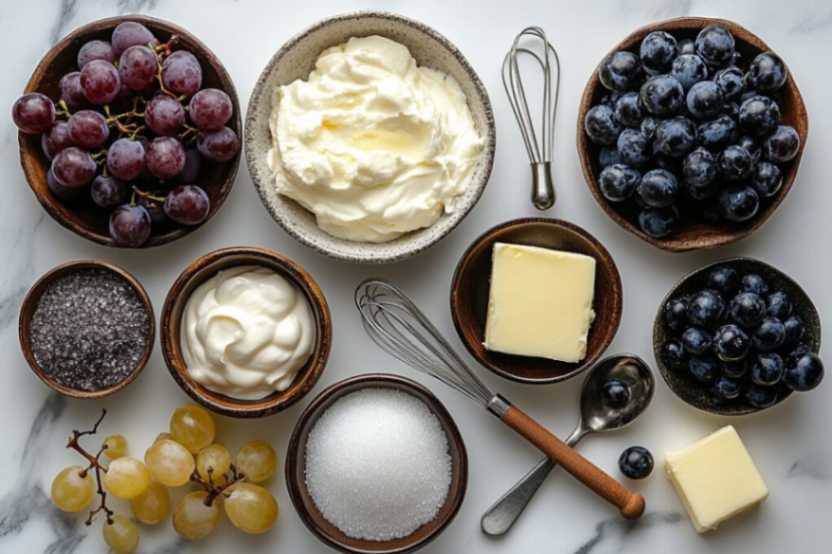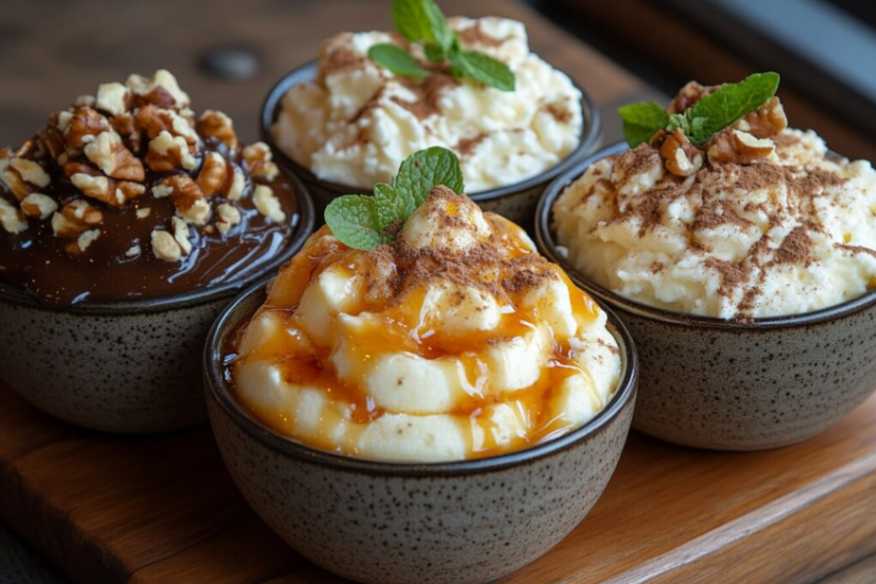The Story Behind Sour Cream Burnt Grapes
From Kitchen Memory to Recipe Revival
We didn’t grow up in the same kitchenor even the same continent. Jacqueline’s childhood smelled of simmering spices and homemade rotis, while Redondo’s world was filled with soft biscuits and Sunday roasts. Still, both of us were shaped by love-filled kitchens and mothers who cooked from the soul.
One quiet night, with leftover grapes and a tired heart, Jacqueline tossed the fruit in brown sugar and roasted them. Redondo spooned the blistered grapes over chilled sour cream and one bite took us back. The warmth, the tang, the sweetness it felt like sitting at our mothers’ kitchen tables again.
That bite became more than comfort. It became sour cream burnt grapes, a dessert born from healing and memory.
Why This Pairing Works: Sweet, Tangy, and Smoky
Roasting transforms grapes. The heat intensifies their natural sugars and concentrates their juice, creating rich, syrupy bites with crispy edges. A few grapes might even charthat’s the magic. Those burnt skins add depth and warmth that balance beautifully with cold, creamy sour cream.
Sour cream, especially full-fat, is key. It softens the sweetness with a gentle tang and creamy base. Every spoonful is a dance of contrast: hot and cold, soft and sharp, sweet and slightly smoky. It’s deceptively simple, incredibly flavorful, and deeply nostalgic.
If you ask us, it’s not just dessert it’s a little taste of love on a plate.
Making Sour Cream Burnt Grapes at Home
Ingredients & Roasting Technique That Caramelizes Naturally
Roasting grapes may sound fancy, but it’s one of the easiest ways to transform everyday fruit into something extraordinary. All you need are red or black seedless grapes, olive oil, and brown sugar. The darker the grape, the richer the roast.
Start by preheating your oven to 425°F. Rinse the grapes and pat them completely dry moisture will keep them from caramelizing. Toss them in a bowl with a light drizzle of olive oil and a sprinkle of brown sugar. Spread them onto a parchment-lined baking sheet in a single layer, leaving space for air to circulate.
Roast for 20 to 25 minutes. Stir once midway through. Some grapes will burst, others will shrivel, and a few may even blacken slightly. Don’t panic those burnt bits bring the flavor that makes this dish unforgettable. Let them cool just slightly before serving.
Tips for the Cream: Choosing and Serving It Right
Not all sour creams are created equal. For this dish, go for full-fat sour cream its richness stands up to the roasted grapes and enhances their sweetness. If you’re out of sour cream, Greek yogurt is a tangier alternative, though less indulgent.
Serve the sour cream cold. Spoon it onto a plate or bowl, letting it rest in the center like a soft cloud. Top with the warm grapes and let their juices drip into the cream naturally. For a dessert spin, drizzle honey or sprinkle cinnamon. For savory edge, add flaky salt or a crack of pepper.
Pair it with crusty toast or enjoy it alone. It’s as cozy as our gluten and dairy free breakfast ideas simple, honest, and quietly elegant.
Creative Ways to Enjoy Sour Cream Burnt Grapes
Pairings and Presentation: What Goes Well With It
Sour cream burnt grapes are stunning in their simplicity, but how you serve them elevates the experience. For casual gatherings, we love spooning them into small glass jars or rustic bowls, topped with a drizzle of honey or a pinch of flaky sea salt. A sprig of thyme or a light dusting of cinnamon adds both aroma and style.
Want something bolder? Serve them on toast points or with crackers as a small-plate appetizer. For a dinner party, go elegant: place the grapes and sour cream into coupe glasses and finish with a drop of aged balsamic vinegar or crushed pistachios.
We once even folded them into a tart shell layered with sour cream and almond crumbs. It vanished in minutes no need for a second opinion.
Brunch, Dessert, or Appetizer? All Three Work
Here’s the secret: this dish doesn’t follow rules. It’s delicious at any time of day. Serve it at brunch beside scrambled eggs and fresh fruit, or as a light dessert after a hearty main course. Its balance of sweet and tangy makes it an unexpected but welcome addition to savory spreads as well.
It also pairs perfectly with sparkling wines prosecco and cava both bring out the roasted grape’s complexity while cleansing the palate between bites. That play of textures and temperatures makes it a standout, much like our bento cakes petite, playful, and rich in flavor.
So don’t box this recipe into one category. Let it roam just like the memories that inspired it.
Understanding Flavor & Technique
What’s the Difference Between Brûlée and Caramelized?
While often confused, caramelizing and brûlée are not quite the same. When you roast grapes, you’re caramelizing drawing out the fruit’s natural sugars and browning them slowly with heat. It’s subtle, rich, and layered, creating syrupy, deep flavors without any added flash.
Brûlée, on the other hand, is bold and fast. It comes from the French word for “burnt” and refers to the act of torching sugar until it forms a crisp, golden crust. Think of the top of crème brûlée that crackle is intentional. You can brûlée grapes by sprinkling them with sugar after roasting and giving them a quick torch treatment.
Want a more decadent finish? Torch the grapes after roasting for a brûléed bite that adds crunch to the softness. Paired with creamy sour cream and maybe even a touch of brown sugar cinnamon butter on toast.it’s a flavor symphony worth repeating.
How to Adjust for Sweetness or Acidity with Grapes
Grapes don’t always arrive ripe or balanced. If your grapes are sour or underripe, roast them longer and sprinkle with a little extra brown sugar. A drizzle of honey after roasting can also round out the tartness.
If your grapes are too sweet, balance them with unsweetened sour cream and a pinch of sea salt. Lemon zest adds brightness and contrast without clashing. You can even stir in a spoon of balsamic vinegar before roasting for depth.
Frequently Asked Questions
What to do with roasted grapes?
Use them on yogurt, toast, or desserts—or serve with meats and cheese.
What is the best way to sweeten sour grapes?
Roast with brown sugar or drizzle honey after. Maple syrup or sweet and sour mix works well too.
How do you make grape brûlée?
Roast grapes, then torch with sugar until crisp. Great over sour cream or paired with bento cakes.
What’s the difference between caramelized and brûlée?
Caramelized = slow, natural browning. Brûlée = torched sugar topping. Both add depth; brûlée adds crunch.
Conclusion
Sour cream burnt grapes might sound unusual, but one bite is all it takes to fall in love. It’s a dish that blends comfort and creativity. where roasted, caramelized grapes meet creamy tang and a hint of nostalgia. Whether served as dessert, brunch, or something in between, it invites conversation and lingers in memory. This recipe isn’t just about flavor it’s about feeling. From our small kitchen to yours, we hope it brings a little warmth, a little surprise, and a whole lot of heart.



